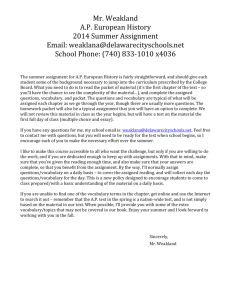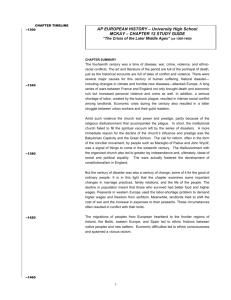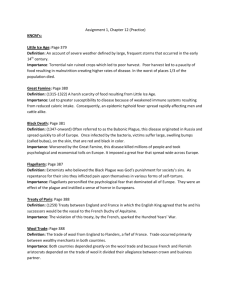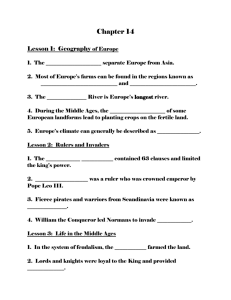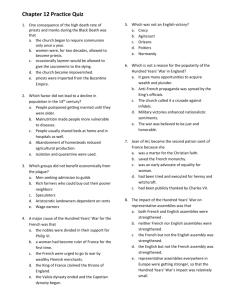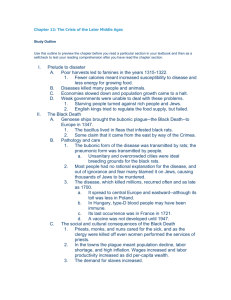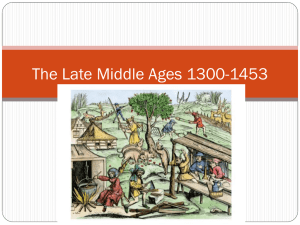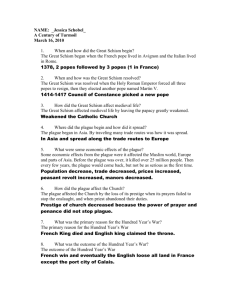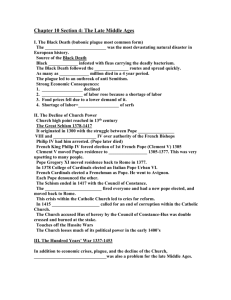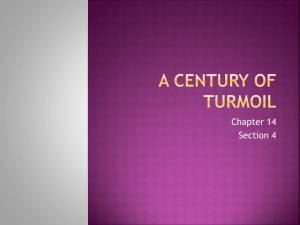AP European History Summer Assignment The summer assignment
advertisement
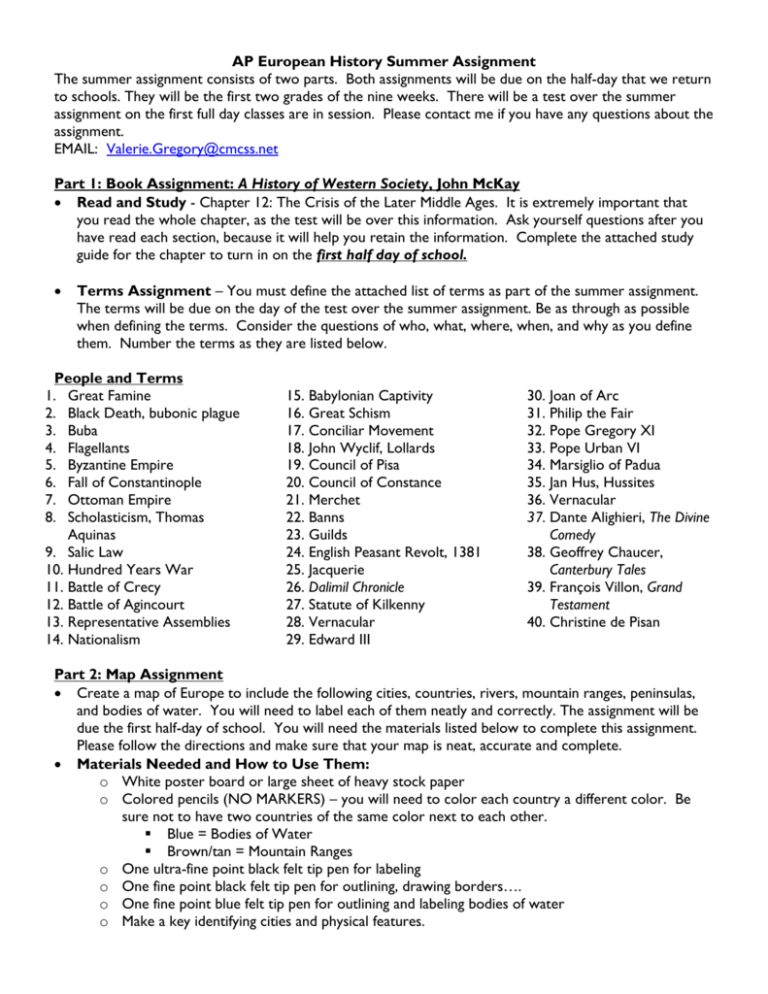
AP European History Summer Assignment The summer assignment consists of two parts. Both assignments will be due on the half-day that we return to schools. They will be the first two grades of the nine weeks. There will be a test over the summer assignment on the first full day classes are in session. Please contact me if you have any questions about the assignment. EMAIL: Valerie.Gregory@cmcss.net Part 1: Book Assignment: A History of Western Society, John McKay Read and Study - Chapter 12: The Crisis of the Later Middle Ages. It is extremely important that you read the whole chapter, as the test will be over this information. Ask yourself questions after you have read each section, because it will help you retain the information. Complete the attached study guide for the chapter to turn in on the first half day of school. Terms Assignment – You must define the attached list of terms as part of the summer assignment. The terms will be due on the day of the test over the summer assignment. Be as through as possible when defining the terms. Consider the questions of who, what, where, when, and why as you define them. Number the terms as they are listed below. People and Terms 1. Great Famine 2. Black Death, bubonic plague 3. Buba 4. Flagellants 5. Byzantine Empire 6. Fall of Constantinople 7. Ottoman Empire 8. Scholasticism, Thomas Aquinas 9. Salic Law 10. Hundred Years War 11. Battle of Crecy 12. Battle of Agincourt 13. Representative Assemblies 14. Nationalism 15. Babylonian Captivity 16. Great Schism 17. Conciliar Movement 18. John Wyclif, Lollards 19. Council of Pisa 20. Council of Constance 21. Merchet 22. Banns 23. Guilds 24. English Peasant Revolt, 1381 25. Jacquerie 26. Dalimil Chronicle 27. Statute of Kilkenny 28. Vernacular 29. Edward III 30. Joan of Arc 31. Philip the Fair 32. Pope Gregory XI 33. Pope Urban VI 34. Marsiglio of Padua 35. Jan Hus, Hussites 36. Vernacular 37. Dante Alighieri, The Divine Comedy 38. Geoffrey Chaucer, Canterbury Tales 39. François Villon, Grand Testament 40. Christine de Pisan Part 2: Map Assignment Create a map of Europe to include the following cities, countries, rivers, mountain ranges, peninsulas, and bodies of water. You will need to label each of them neatly and correctly. The assignment will be due the first half-day of school. You will need the materials listed below to complete this assignment. Please follow the directions and make sure that your map is neat, accurate and complete. Materials Needed and How to Use Them: o White poster board or large sheet of heavy stock paper o Colored pencils (NO MARKERS) – you will need to color each country a different color. Be sure not to have two countries of the same color next to each other. Blue = Bodies of Water Brown/tan = Mountain Ranges o One ultra-fine point black felt tip pen for labeling o One fine point black felt tip pen for outlining, drawing borders…. o One fine point blue felt tip pen for outlining and labeling bodies of water o Make a key identifying cities and physical features. Cities Amsterdam Antwerp Athens Barcelona Belfast Berlin Brussels Bucharest Budapest Copenhagen Dresden Dublin Florence Frankfurt Gdansk Geneva Glasgow Gibraltar Helsinki Istanbul (Constantinople) Kiev Krakow Lisbon Liverpool London Madrid Manchester Milan Minsk Moscow Munich Naples Nuremberg Oslo Paris Prague Rome St. Petersburg (Leningrad) Salzburg Sarajevo Stockholm Venice Vienna Volgograd (Stalingrad) Warsaw Zurich Map Terms Countries Albania Austria Belarus Belgium Bosnia-Herzegovina Bulgaria Croatia Cyrus Czech Republic Denmark Estonia Finland France Germany Great Britain Greece Hungary Ireland Italy (and Sicily) Latvia Lithuania Liechtenstein Luxembourg Macedonia Malta Montenegro Netherlands Norway Poland Portugal Romania Russia Serbia Slovakia Slovenia Spain Switzerland Turkey Ukraine Vatican City Bodies of Water Adriatic Sea Aegean Sea Atlantic Ocean Baltic Sea Black Sea Caspian Sea Dardanelles English Channel Mediterranean Sea North Sea Strait of Gibraltar Rivers Danube Elbe Po Rhine Rhone Seine Thames Volga Peninsulas Balkan Crimean Iberian Jutland Scandinavian Mountain Ranges Alps Caucasus Pyrenees Ural Optional Assignment – The following are a list of terms that it would be useful to know as we cover the Renaissance. You will need to use outside sources to find most of these terms. You can choose to do some of the terms or all of them. The more terms that you complete, the more bonus points you earn (up to 10 points). Be as through as possible when defining the terms or you will not be rewarded with the bonus points. 1. Carruca 2. Three-field system 3. Chivalry 4. Knighthood 5. Truce (Peace) of God 6. Eleanor of Aquitaine 7. Annulment 8. Venice 9. Flanders 10. Champagne 11. Borough/burgh 12. Communes 13. Charters of liberty 14. Craft guilds 15. Putting out-system 16. Universities (medieval) 17. Irneriu 18. Liberal arts 19. Atrium baccalaureus 20. Town v. gown 21. Aristotle 22. Averroes 23. Scholasticism 24. Realists v. Nominalists 25. Thomas Aquinas 26. Summa Theologica 27. Troubadours 28. Vernacular 29. Chanson de geste 30. Song of Roland 31. Romanesque 32. Barrel vault 33. Gothic 34. Pointed arch 35. Flying buttress 36. Abbot Suger 37. Saint-Denis 38. Norman Conquest 39. Common law 40. Parliament 41. Frederick II 42. Teutonic knights 43. Pope Gregory VII Concordat of Worms 44. Pope Innocent III 45. St. Francis of Assisi 46. Beguines 47. Relics 48. Cathars (Albigensians) 49. Seljuk Turks 50. Excommunication 51. Pope Urban at Clermont 52. Fourth Crusade 53. Doomsday Book 54. Thomas Beckett 55. Capetian Dynasty 56. Estates-General 57. Alexander Nevsky 58. Lay investiture 59. Papal monarchy 60. Poor Clares 61. Cistercians 62. Scaraments 63. Holy Office/Inquisition 64. Battle of Manzikert 65. Crusader States 66. Oath of Salisbury 67. Magna Carta 68. Phillip II Augustus 69. Frederick Barbarossa 70. The Mongols 71. Curia 72. St. Bernard of Clairvaux 73. “Little Ice Age” 74. Pogroms 75. Wat Tyler & John Ball 76. Gunpowder 77. Duke of Orleans 78. The Visconti & d’Este 79. Council of Ten 80. Catherine of Sienna 81. Purgatory 82. Modern Devotion 83. Nominalism 84. Petrarch’s sonnets 85. Guiotto 86. Decameron 87. Statue od Laborers 88. The Ciompi 89. Henry V 90. The gabelle & the taille 91. Golden Bull of Charles IV 92. Unam Sanctum 93. Marsiglio of Padua 94. Brothers of the Common Life 95. The four humors 96. Canterbury Tales 97. Yersina pestis 98. The Jacquerie 99. Longbow 100. Grandi & popolo grasso 101. Anti-christ 102. Dominicans 103. Pilgrimages 104. Meister Eckhart 105. William of Occam 106. Abelard & Heloise AP European History Name________________________ Chapter 12: The Crisis of the Middle Ages A. True or False Where the statement is true, mark T. Where it is false, mark F, and correct it in the space immediately below. ___ 1. The conciliar movement was most interested in further increasing the power of the pope in relation to secular rulers. ___ 2. In reaction to the calls for reform in the fourteenth century, the church did not enter into a period of reform and rejuvenation. ___ 3. Prior to the plague in 1348, Europe experienced a period of unusually good harvests. ___ 4. John Wyclif argued that scripture was the sole authority in Christianity. ___ 5. Up to the nineteenth century, economic factors usually determined whom and when a person married. ___ 6. For the most part, job mobility within the late medieval guilds tended to increase. ___ 7. The bubonic plague was most often caused by airborne particles from the excrement of the Asian black rat. ___ 8. The Great Schism resulted from competition between two popes, each who declared that he was the only true pope in Christendom. ___ 9. The advent of the cannon and gunpowder ultimately reduced the power of the nobility and increased the power of emerging national states. ___ 10. John Hus led a reform movement in Bohemia that was similar to that of John Wyclif in England. B. Multiple Choice Select the best answer and write the proper letter in the space provided. ___ 1. The conciliar movement was a. an effort to give the pope the power to use councils to wipe out heresy. b. the effort by the French lords to establish a parliament. c. a new monastic order vowing poverty. d. an attempt to place ultimate church authority in a general council. ___ 2. The plague was probably brought into Europe by a. Chinese soldiers. b. Spanish warriors returning from South America. c. English soldiers pushing into France. d. Genoese ships from the Crimea. ___ 3. In general, farm laborers who survived the bubonic plague faced 4 a. higher wages. b. food shortages. c. the need to migrate. d. excommunication from the church. ___ 4. Generally, the major new source of criminals after the Hundred Years’ War was a. the urban mobs. c. the nobility. b. the rural peasants. d. the bourgeoisie. ___ 5. Which of the following statements about the fourteenth century is false? a. The population declined. b. The standard of living fell drastically. c. The power of the church declined. d. War between England and France was frequent. ___ 6. Most people in the fourteenth century believed that the Black Death was caused by a. bad air. c. a bacillus living in fleas. b. poor sanitation and housing. d. black rats. ___ 7. Generally, the plague disaster of the fourteenth century resulted in all of the following for European society EXCEPT a. higher wages for most workers. b. a decline in the number of German clergymen. c. a decline in flagellantism. d. an obsession with death. ___ 8. Which of the following did NOT participate in the Hundred Years’ War? a. Edward III of England b. King Philip the Fair c. Joan of Arc d. The Dauphin Charles of France ___ 9. One reason for peasant-landlord conflict in the fourteenth century was a. peasants’ opposition to declining wages and inflation. b. landlords’ attempts to legislate wages. c. land scarcity. d. peasants’ refusal to be drafted for war service. ___ 10. The author of Defensor Pacis and proponent of the idea that authority in the Christian church rested in a general council rather than in the papacy was a. Cardinal Robert of Geneva b. Pope Urban V. c. John Wyclif. d. Marsiglio of Padua ___ 11. Which of the following statements about the Hundred Years’ War is true? a. It discouraged representative government. b. It depressed the English wool trade. c. It increased the amount of arable land in England. d. It created a surplus of manpower. ___ 12. The followers of the English theologian-reformer Wyclif were called 5 a. Protestants. b. outlaws. c. Lollards. d. flagellants. ___ 13. Fur-collar crime is a term used to describe a. the robbery and extortion inflicted on the poor by the rich. b. the criminal activity carried out by bandits such as Robin Hood c. crimes committed by churchmen. d. the illegal activities of noblewomen. ___ 14. After 1347, the Black Death generally moved a. from north to south. b. from west to east. c. from south to north. d. from east to west. ___ 15. Initially, the Hundred Years’ War was fought over a. Aquitaine. b. King Edward III’s claim to the French crown. c. the control of the Flemish wool trade. d. religion. ___ 16. English military innovation(s) during the Hundred Years’ War included a. the crossbow. c. cavalry. b. the cannon and the longbow. d. the pike. ___ 17. Which of the following statements about marriage during the Middle Ages is true? a. Most marriages were based on romantic love. b. Most marriages were arranged. c. Divorce was common. d. Marriage without the church’s sanction was unheard of. ___ 18. Which of the following was a writer of vernacular literature? a. Dante c. Clement VII b. Jacques de Vitry d. Marsiglio of Padua ___ 19. Which of the following statements about Joan of Arc is FALSE? a. She dressed like a man. b. The English king was her greatest supporter. c. She was accused of being a heretic and was burned. d. She was from a peasant family. ___ 20. For the French, the turning point of the Hundred Years’ War was a. the relief of Paris. b. the defeat of the English fleet in the English Channel. c. the relief of Orléans. d. the Battle of Poitiers. ___ 21. Prostitution in late medieval society a. did not exist. b. existed only among the lower classes. 6 c. was not respected but was legalized. d. existed in the countryside but not the city. ___ 22. In the fourteenth century craft guilds began to change in that a. master and journeyman distinctions began to disappear. b. the guilds lost control over the production process. c. apprenticeship was abandoned. d. membership became more restrictive and master-journeyman relations deteriorated. ___ 23. Chaucer’s Canterbury Tales is important because a. it depicts the impact of the plague on Italian life. b. it reflects the cultural tensions of the time. c. it illustrates the highly religious interests of most people. d. it shows how people were obsessed with the next world. ___ 24. The effect of the Hundred Years’ War on England was that it a. brought great wealth in the form of cash reserves to England. b. caused a great increase in wool exports. c. allowed many English knights to become very rich. d. resulted in a great net loss in cash. C. Identification Supply the correct identification for each numbered description. ________________ 1. Czech religious reformer who was ultimately burned at the stake. ________________ 2. Crisis in the Catholic Church during the 14th century during which two popes lay claim to leadership of the Church. ________________ 3. Organizations of skilled workers who sought to maintain a monopoly on certain trades and who were selective in the recruitment of new members. ________________ 4. Italian poet who wrote one of the great vernacular works of the 14th century: The Divine Comedy. ________________ 5. French female writer whose work, The City of Ladies, lists the great women of history and their contributions to society. ________________ 6. Prolonged military conflict that resulted in the removal of English influence in France by the mid-fifteenth century. ________________ 7. 14th-century writer that argued that the state should be more powerful than the church. ________________ 8. Reform movement that sought to create a council of cardinals that would be more powerful than the pope. ________________ 9. New innovation that revolutionized warfare and made castles vulnerable to attack. 7 8
